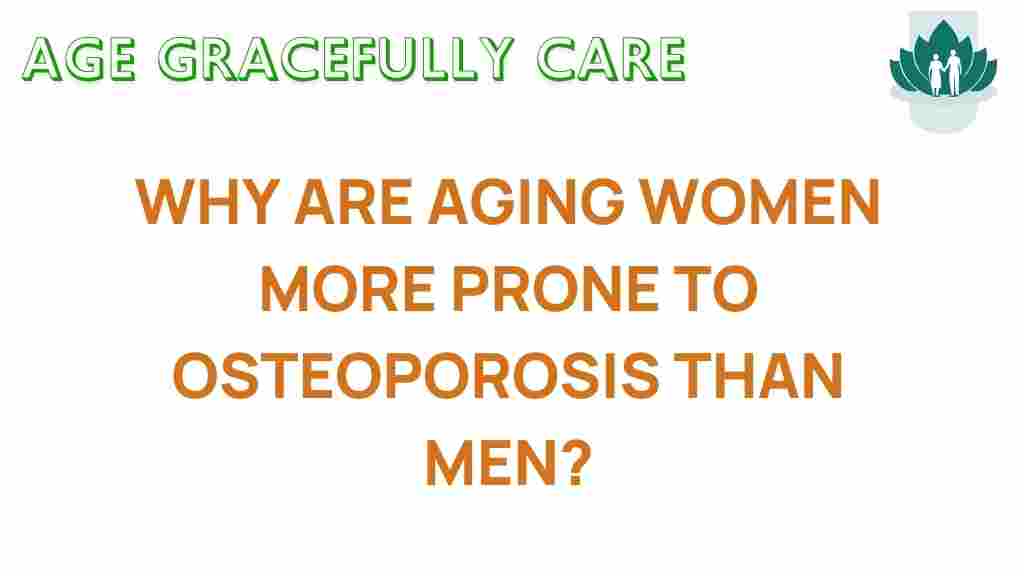Unraveling the Mystery: Why Are Aging Women More Susceptible to Osteoporosis?
Osteoporosis is a significant health concern that primarily affects aging women, leading to increased risk of fractures and other complications. As women age, especially post-menopause, they undergo various physiological changes that can impact their bone health. In this article, we will delve into the reasons behind the heightened susceptibility of aging women to osteoporosis, focusing on factors such as hormone levels, risk factors, prevention strategies, and the importance of calcium and vitamin D.
Understanding Osteoporosis
Osteoporosis is a condition characterized by decreased bone density and increased fragility of bones. This disease makes bones more susceptible to fractures, which can lead to severe health complications. Understanding the underlying mechanisms of osteoporosis is crucial, especially for aging women who are at a higher risk. Here are the primary factors that contribute to osteoporosis:
- Low bone mass
- Bone tissue deterioration
- Hormonal changes, particularly after menopause
Hormone Levels and Bone Health
One of the most significant reasons why aging women are more susceptible to osteoporosis is the decline in hormone levels, particularly estrogen. Estrogen plays a critical role in maintaining bone density. During menopause, which typically occurs between the ages of 45 and 55, estrogen levels drop significantly. This reduction can lead to:
- Increased bone resorption (breakdown)
- Decreased bone formation
- Accelerated bone loss, particularly in the first few years post-menopause
As a result, women can lose up to 20% of their bone mass in the first five to seven years after menopause, making them particularly vulnerable to osteoporosis during this time. Understanding these hormonal changes is essential for addressing and managing bone health in aging women.
Risk Factors for Osteoporosis in Aging Women
Several risk factors contribute to the increased incidence of osteoporosis among aging women. These can be categorized into non-modifiable and modifiable factors:
Non-Modifiable Risk Factors
- Age: The risk of osteoporosis increases with age.
- Gender: Women are at a higher risk compared to men.
- Family History: A family history of osteoporosis can increase risk.
- Ethnicity: Caucasian and Asian women are at greater risk.
Modifiable Risk Factors
- Calcium and Vitamin D Intake: Insufficient intake can lead to decreased bone density.
- Lifestyle Choices: Smoking and excessive alcohol consumption can weaken bones.
- Physical Activity: Lack of weight-bearing exercise can contribute to bone loss.
- Medications: Certain medications, such as corticosteroids, can negatively impact bone health.
By understanding these risk factors, aging women can take proactive steps to mitigate their risk of developing osteoporosis.
The Importance of Calcium and Vitamin D
Calcium and vitamin D are vital for maintaining bone health, especially in aging women. Here’s how each plays a role:
Calcium
Calcium is a key mineral that helps build and maintain strong bones. The recommended daily intake of calcium for aging women is around 1,200 mg. Sources of calcium include:
- Dairy products (milk, yogurt, cheese)
- Leafy green vegetables (kale, broccoli)
- Fish with soft bones (sardines, salmon)
- Fortified foods (orange juice, cereals)
Vitamin D
Vitamin D helps the body absorb calcium. The recommended daily intake for aging women is about 800-1,000 IU. It can be obtained through:
- Sun exposure (the body produces vitamin D when skin is exposed to sunlight)
- Fatty fish (tuna, mackerel)
- Fortified foods (milk, some cereals)
- Supplements, if necessary
Ensuring adequate intake of calcium and vitamin D is crucial for the prevention of osteoporosis in aging women.
Gender Differences in Osteoporosis
Gender differences play a significant role in the prevalence of osteoporosis. Men generally have a higher peak bone mass than women, and they lose bone density at a slower rate as they age. This leads to a lower overall risk of osteoporosis in men compared to women. Some important points to consider include:
- Women typically have lower bone density than men throughout their lives.
- The rapid decline in estrogen levels post-menopause greatly increases women’s risk.
- Women usually live longer than men, leading to prolonged exposure to risk factors.
Understanding these gender differences is essential for creating targeted prevention and treatment strategies for osteoporosis.
Prevention Strategies for Aging Women
Preventing osteoporosis involves a multi-faceted approach focusing on lifestyle changes, dietary habits, and medical interventions. Here are some effective strategies:
- Nutrition: Ensure adequate intake of calcium and vitamin D.
- Exercise: Engage in regular weight-bearing and muscle-strengthening activities.
- Avoid Smoking: Quitting smoking can significantly improve bone health.
- Limit Alcohol: Keep alcohol consumption to moderate levels.
- Regular Check-ups: Get bone density tests and discuss risk factors with healthcare providers.
By adopting these preventive measures, aging women can significantly reduce their risk of developing osteoporosis.
Troubleshooting Tips for Osteoporosis Management
If you or a loved one is facing osteoporosis, consider the following tips for effective management:
- Consult a Healthcare Provider: Regular consultations can help tailor a treatment plan based on individual needs.
- Consider Medications: In some cases, medications may be necessary to enhance bone density.
- Stay Informed: Educate yourself about osteoporosis and available treatments.
- Join Support Groups: Connecting with others facing similar challenges can provide emotional support and practical advice.
Managing osteoporosis is a continuous process that requires diligence and adaptability.
Conclusion
Osteoporosis is a complex condition that significantly impacts aging women due to various factors, including hormonal changes, dietary deficiencies, and lifestyle choices. By understanding the underlying mechanisms leading to osteoporosis and implementing effective prevention strategies, aging women can protect their bone health and reduce their risk of fractures. Remember, it is essential to consult healthcare professionals for personalized advice and treatment options.
For more information on osteoporosis and bone health, visit Osteoporosis Foundation. Additionally, you can explore practical tips on maintaining a healthy lifestyle by checking out this resource.
This article is in the category Health and created by AgeGracefullyCare Team
